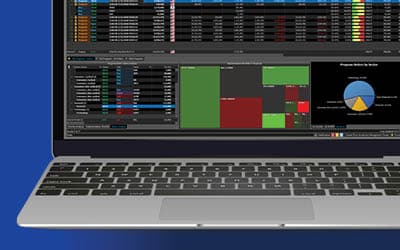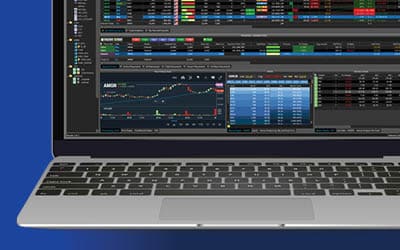Speaking of Alpha: The Evolution of Superannuation Operating Models
Delivering Member Outcomes at Scale: Frank Smietana in conversation with Peter Sherriff and Clayton Issitt. Our Speaking of Alpha series features insights and commentary from State Street Alpha® experts on data, operations, technology and services. Frank Smietana,...
Introducing Charles River for Private Markets
By Spiros Giannaros In an effort to simplify our branding and how we represent ourselves to our clients and the general marketplace, we are retiring the Mercatus brand and introducing a new name for our front and middle office technology solution for private markets:...
Speaking of Alpha: Democratizing Data Access for Asset Owners and Investment Firms
Eliminating Silos and Harnessing Interoperability. By democratizing access to curated, role-appropriate data, institutional investors empower their employees and stakeholders to make timelier and more confident investment decisions, transform their operating models...
Speaking of Alpha: Enabling a Whole of Fund View for Canadian Pensions to Accelerate Data-driven Investment Insights
In this article, our panelists discuss industry challenges and the role that State Street plays in providing pensions with timelier insights into their investments and associated risk exposures. Canadian pensions are among the most sophisticated institutional...
Speaking of Alpha: Modernizing Investment Operations for Insurers
In this article, our panelists discuss the challenges insurers face today and how our cross-disciplinary teams apply decades of expertise across the front-, middle- and back-office to help clients transform their operating model and drive sustainable growth. Insurance...
Data for Investment Managers: Evolution or Revolution?
The role of data and technology in the investment management industry is evolving rapidly. How do businesses leverage such new advances efficiently and to maximum effect?The role of data and technology in the investment management industry is evolving rapidly. How do...
Speaking of Alpha: Leveraging Partnerships to Evolve your Data Architecture
Frank Smietana in conversation with Karthik Rajagopalan and Peter Sherriff. Investment managers and asset owners increasingly rely on partnerships with third-party data, analytics and application providers to support investment and risk decision making, bring new...
Speaking of Alpha: Helping Superannuation Funds Transition to a Total Portfolio Approach
A conversation with Sandra Ng, Yulan Lu and Clive Maguchu. Asset owners are increasingly challenged to provide their beneficiaries with outcome-based solutions that address individual preferences around risk, liquidity and ESG concerns. Traditional portfolio...
Leveraging MSCI Fixed Income Models & Analytics in Charles River IMS
Factor-based modeling and analytics play a central role in helping portfolio managers decompose risk, facilitate stress testing, generate risk forecasts and attribute performance. Open architecture platforms such as the Charles River Investment Management...
Why Should Super Funds Strive for a ‘Whole-of-fund’ View?
Superannuation funds will benefit if they can gain a comprehensive perspective on their assets. Peter Sherriff, director of Product Strategy (Asia Pacific) at Charles River Development, explains why the ‘whole-of-fund’ approach is gaining popularity across...
Viewpoints: Improving Fixed Income Liquidity Access and Efficiency with LTX in Charles River
Harnessing AI-driven Insights. The search of liquidity in fragmented fixed income markets has spawned over a hundred venues globally, some of which offer new trading protocols and approaches to liquidity discovery and trade execution. Charles River’s open...
Australia’s Superannuation Funds Seek to Update their Operations
There is an increasing pressure on Australian super funds to ensure their operating models are fit-for-purpose in a rapidly changing retirement fund landscape.There is an increasing pressure on Australian super funds to ensure their operating models are...
T+1 is Coming in 2024
The Securities and Exchange Commission (SEC) has finalized its rule that will require trade settlement one business day after execution, shifting from T+2 to T+1. The SEC’s rationale behind the shortened settlement time is to benefit market participants by reducing...
Viewpoints: Advocating for Equity
An interview with Ruby Chiu, Head of Client Management at Charles River. Embrace Equity is the theme of International Women’s Day 2023. But what is equity, and how does it differ from equality? Equality means each individual or group of people is given...
Viewpoints: Portfolio Customization in Wealth Management
The Innovative Power of Tailored Portfolio Solutions. Demand for customized portfolios among individual investors is growing and the industry has responded with sharp increases in acquisitions and product offerings in the marketplace. Charles River convened a panel...
Speaking of Alpha: Shaping the Future of Data Management
Data is at the heart of every investment firm’s operations. An effective data management strategy can help asset allocators and institutional investment and wealth managers uncover new insights, simplify their operating model and better serve their clients. Investment...
Speaking of Alpha: Empowering Asset Managers through Data Driven Transformation
A conversation with Brian Allis, Jochen Kuehn and Simon Brown. Data is central to an asset manager’s investment process. An effective data management strategy can help firms uncover new insights, better serve emerging stakeholder requirements, and bring new products...
FundGuard and State Street Alpha: Creating a Unified Book of Record for Investment Managers
How FundGuard’s partnership with State Street AlphaSM can transform investment and fund accounting for your business. State Street Alpha has partnered with FundGuard, a leading provider of fund and investment accounting systems and software, to co-engineer a solution...
FactSet and State Street Alpha: Maximizing the Value of Investment Data
State Street Alpha has partnered with FactSet to give its clients access to a broad range of differentiated investment information. Data is one of the most important entities within the asset management industry. Without accurate and timely data, firms struggle to...
Speaking of Alpha: A Holistic Approach to Managing Benchmark and Index Data
Introducing the State Street Alpha and Rimes Partnership: With the shift to passively managed investments and the rapid growth of ESG-themed products over the past decade, indexes and benchmarks have become central to the investment lifecycle. State Street recently...
Speaking of Alpha: Helping Asset Allocators Become Data-Driven Organizations
A conversation with Bruce Feibel and Kishore Kottapalli "The ability to harness large volumes of portfolio, market, and reference data from multiple sources in a flexible and easily accessible manner creates new opportunities for forward-looking asset...
Sanctions Screening in APAC Capital Markets
The launch of sanctions globally in response to Russia’s invasion of Ukraine has reminded buyside firms of the need for robust screening processes. Effective sanctions screening requires timely, accurate and complete data across investment and operational functions....
The Path to Direct Indexing in Canada: Opportunities and Considerations
It’s no secret that direct indexing has taken off in the U.S. – an avalanche of high-profile acquisitions, fintech startups, and major platform launches have occurred over the last few years and momentum does not appear to be slowing. While direct index portfolios...
Speaking of Alpha: Positioning APAC Asset Owners for Growth
Technology, Services & Operational Transformation: A conversation with Lucy Chen, Peter Sherriff & Clayton Issitt. APAC asset owners are increasingly looking to build scale, either through mergers, expanding into new geographies and asset classes, or...
Viewpoints: The Evolving Role of ESG for APAC Asset Owners
Managing Environmental, Social and Governance (ESG) goals and commitments is increasingly top of mind for pensions, insurance companies and sovereign wealth funds in APAC. Collectively, APAC asset owners hold more AUM than any other region globally, and these...
Holistic Data Management: How Asset Owners Can Turn Data into a Competitive Advantage
By Peter Sherriff, Director of Product Strategy, APAC. Asset owners across the globe are increasingly data driven. Whether evaluating external manager performance, analyzing market and economic scenarios, or designing new investment options for their members, accurate...
What Is Scenario Analysis in Private Markets? (And Why Is It So Hard to Do?)
In 2021, State Street acquired Mercatus, Inc. a premier front-and-middle-office solutions and data management provider for private market managers. In this ongoing series of Insights, Mercatus subject matter experts explain how their technology helps Charles River and...
How State Street Alpha’s Strategic Partnerships can Benefit your Business
Who is State Street Alpha Partnering With and Why?Why We Partner: Investment organizations of all kinds face secular headwinds. Increased competition, commoditization of returns, fee and cost pressures, and a constantly evolving regulatory environment all pose...
A Look Back at 2021 – New Pathways to Growth
By Spiros Giannaros, President and CEO, Charles River. If 2020 was about maintaining business as usual in a most unusual time, 2021 has been about continuing to adapt to an evolving pandemic and finding new ways to succeed and grow. Thanks to our customers,...
The Evolution of ESG from Funds to Custom Portfolios
This article addresses the limitations and risks of negative screening within separately managed accounts and the opportunities that technology and newer portfolio construction approaches offer to wealth and asset managers seeking to offer these products at scale and...
Meet Mercatus: The Latest Addition to the Charles River Development Family
By Spiros Giannaros, CEO, Charles River. We are excited to welcome the Mercatus team to Charles River Development in an acquisition that was finalized by State Street earlier this month. We’ll have lots more to share about Mercatus, its technology, and our end-to-end,...
Platforms and Partnerships: Helping Investment Managers Keep Pace with Growing Complexity
By Spiros Giannaros, President and CEO, Charles River. A number of forces are injecting new complexities into capital markets. Growing investor demand for access to private markets, the search for diversification and differentiation in a crowded world of low-cost...
Speaking of Alpha: Evolution of Outsourced Data Management
Outsourced data management lets firms rethink their operating models and focus on their core competencies. The growing sophistication and complexity of institutional portfolios create new demands on in-house data management teams. Outsourcing presents firms with an...
The Evolving Fixed Income Trading Landscape: Leveraging Connectivity, Interoperability and Automation
By: Alun Cutler, Director, Product Management, EMEA. Charles River has recently been honored as the recipient of “Best Fixed Income OEMS” in the inaugural European Markets Choice Awards. We’d like to share some thoughts on where we see the near-term future of fixed...
“Rightsourcing” APAC Asset Owner Operating Models
By Peter Sherriff, Director of Product Strategy, APAC. Asset owners globally are evaluating their operating model to determine what assets and investment activities should be managed internally and which make sense to outsource. Many asset owners with over USD30...
Reimagining Buy-Side Data Management
State Street report reveals how cloud-based data management is giving firms a competitive advantage, reducing costs and driving innovation Margin compression driven by investor’s growing adoption of low-fee index funds increasingly forces buy-side firms to do more...
Direct Indexing: 2020’s Surge is Just the Beginning
By: Randy Bullard, Global Director of Wealth Management. Direct or personalized index portfolios have been utilized by high net worth investors for over 20 years. Firms like Parametric Portfolio Associates and Aperio have promoted them through separate account...
A Platform for Change, A Platform for Now
By: Melissa Monahan, Campus Recruiting Lead. Last year marked State Street’s 14th year as the presenting sponsor of the Annual Massachusetts Conference for Women, which celebrates, supports, and encourages women and their contributions to the workplace. Traditionally,...
Speaking of Alpha: Platforms, Ecosystems and Interoperability
A technology ecosystem is key to helping deliver fit-for-purpose solutions and services while reducing operational cost and complexity. Read how State Street Alpha enables connectivity and interoperability with a vibrant ecosystem of third-party providers. All...
“Anecdata” – What Traders Know, and How to Make Trade Automation Intelligent
Charles River Investment Management Solution is helping traders to systematize their accumulated knowledge and leverage it to increase efficiency, improve execution quality and better quantify the “whys” of trade decisions. by Kyle Pedrotty and Jay Hinton. In...
Building Trust in Trade Automation
by Kyle Pedrotty and Jay Hinton. Trade automation is the topic we get asked about most often lately. Firms want to know how we can help them address the fact that they have fewer traders handling more orders. But when we speak with traders, we hear their desire to...
Supporting ESG Investing for APAC Asset Owners
By Peter Sherriff , Director, Product Strategy, Asia PacificCharles River Development Across the Asia-Pacific (APAC) region, asset owners in both developed and emerging markets are keen to adopt Environmental, Social and Governance (ESG) investment practices. Whilst...
Traders with Machines: Why Trade Automation is Cooperative Game Theory and not a Zero-Sum Game
by Kyle Pedrotty and Jay Hinton. One of the hottest topics for institutional traders in 2020 has been the impact of automation on trading workflows. Charles River has been actively working in this area as well, and we recently launched a new product development team...
Helping APAC Asset Owners Navigate Regulatory Change
By Peter Sherriff, Director of Product Strategy, APAC. In our second Insight discussing the challenges and opportunities facing APAC asset owners, we examine regulatory headwinds and their impact on asset owner operating models and growing reporting obligations....
Helping APAC Asset Owners Address Liquidity Challenges
By Peter Sherriff, Director of Product Strategy, APAC. In part one of this series exploring the challenges and opportunities facing APAC asset owners, we discuss recent pandemic-driven liquidity issues and the tools that organizations are using to measure and manage...
Maintaining Business as Usual in the Most Unusual of Times
by Spiros Giannaros President, Charles River Development In the months since mass quarantines swept the globe, the topic of resilience has surfaced repeatedly in my daily conversations with customers. Portfolio management and trading has traditionally been a...
UX Insights Article: The Grid is Dead. Long Live the Grid.
by Jay Hinton and Sean Jacobs Look at any marketing material for a trading application, and you’ll quickly come to the conclusion that the trading applications of the future will have no grids—it will be all graphs, blinking lights and price tiles. At the same time,...
Delivering a High Quality User Experience to the Front Office: The Importance of Themes, and Why the Dark Matters
by Jay Hinton and Sean Jacobs Summary: While user interface (UI) color choices may seem arbitrary or tied to individual preferences, an emerging trend seems to reveal that color does matter for a number of cognitive and physiological reasons. The end result is an...
How Asset Manager M&A Impacts FX Trading Technology Choices, Part 2
In Part 1 of this two-part series, we discussed some of the challenges around order generation in FX management that confront asset managers undergoing a merger or acquisition. Specifically, we looked at issues that arise when firms seek to combine and rationalize...
How Asset Manager M&A Impacts FX Trading Technology Choices, Part 1
Mergers and acquisitions between asset management firms are at a historical high, driven by margin compression, the ascendance of passive management, and growing regulatory compliance costs. A thorny FX management challenge facing asset management firms is the need to...
The Future of Fixed Income is Adaptive
In our previous Insight covering the key themes at the 2019 Fixed Income Leaders Summit (FILS), we highlighted how electronic trading has grown in sophistication, and how trade automation is now a requirement for asset managers needing to construct, de-risk or...
Moving from Electronification to Automation in Fixed Income Markets
Charles River Development has been an active participant in the annual Fixed Income Leaders Summit (FILS) since the inaugural event in 2014. The caliber of presentations, panel discussions, and networking opportunities ranks FILS as a key event for investment...
Liquidity, Execution and Collaboration: Old Problems, New Solutions
Now in its fourth year, the 2018 Fixed Income Leaders Summit (FILS) drew record attendance from buy-side firms, trading venues and technology vendors. Charles River has participated in this event since the start, and we’ve worked with our buy-side clients and...
The New OTC Challenge: Optimizing Collateral Management in the Front and Middle Office
Collateralized OTC derivatives transactions help firms reduce credit risk when dealing with smaller, less capitalized counterparties, during periods of market shocks, and when holding long-dated positions. However, managing, monitoring and optimizing collateral places...
Creating Efficiencies and Reducing Operational Risk with an Investment Book of Record (IBOR)
An increasingly critical middle office function is delivering accurate and timely position data to the front office and ensuring redundancy with outsourced back-office services. This article discusses the operational, regulatory and competitive drivers for automated...
Rethinking the Middle Office: Solving Buy-side Challenges with Financial Technology
The buy-side middle office is undergoing significant change, as new regulations, increased use of OTC derivatives and fee compression force firms to reevaluate their existing staffing, workflows and technology. This Insight explores those changes, and discusses how a...
Designing Smart Beta Portfolios (PART 2): The Role of Factor Models and Technology Considerations
Charles River recently discussed how Smart Beta products can improve portfolio diversification, minimise undesirable correlation risk, and deliver better risk-adjusted performance. This article continues the discussion, focusing on the pivotal role of factor models in...
Designing Smart Beta Portfolios (PART 1): Challenges and Considerations
Increasingly popular Smart Beta products provide investment managers and asset owners with conveniently packaged exposure to a number of factors. Risk factors are granular attributes of one or more asset classes that explain risk and return. Read Part 2 - Designing...
MiFID II Transaction Reporting Challenges for the Buy-Side
We discuss the key role that technology plays in helping buy-side firms achieve compliance with the regulation’s extensive trade and transaction reporting requirements. Technology solutions must integrate dozens of reporting fields from disparate OMS/EMS, legal...
How Fund Look-through Improves Buy-side Risk Monitoring & Performance Evaluation
Asset managers and owners increasingly implement their investment strategy by buying funds from a number of providers. These funds can represent a significant portion of the firm’s portfolio, and complicate their ability to manage risk, measure performance and comply...
Two Approaches to Buy-Side Scenario Analysis
Buy-side firms increasingly offer a diverse set of funds and products to meet the risk appetites and investment objectives of their institutional clients. Multi-asset, long-only, and leveraged portfolios all have very different characteristics that require front and...
Understanding Mortgage Prepayment Models
U.S. agency residential mortgage-backed securities (RMBS) are the largest and most liquid securitized asset class in the world. Pooling thousands of individual mortgages into a standardized security lets investors easily gain exposure to this important asset...
A Buy-Side Framework for Managing OTC Derivatives
Learn how several regulatory and structural drivers are affecting buy-side usage of OTC derivatives, leading to higher trading costs and a fundamental reshaping of technology infrastructure for managing derivatives. Charles River Development discusses those challenges...
Minimizing Performance Dispersion between Models and SMAs
A recent FundFire article found that “performance of portfolios in models-based managed account programs can sometimes diverge from the separately managed account (SMA) strategies they aim to track. Some performance differences can be expected, due to the timing of...
Scaling SMAs to Improve Investment Performance
Separately Managed Accounts (SMAs) are a widely used investment vehicle for endowments, retirement plans, foundations, and wealth managers. The popularity of SMAs is underscored by broad global institutional sponsorship and investor acceptance. As of 2015, more than...
Turning the DoL Fiduciary Rule into Opportunities for Wealth Managers
The Department of Labor (DoL) Fiduciary Rule requires financial advisors to meet a fiduciary, rather than a suitability, standard when recommending investment products for their clients’ retirement accounts. This will significantly impact asset managers, wirehouses,...
TABB Forum Fixed Income 2017 – Liquidity, Price Transparency and Regulations
Charles River discusses The Future of Fixed Income Market Structure and Trading Analytics with TABB Forum. Topics include MiFID regulatory reporting obligations, execution analysis and efficiently sourcing liquidity from the growing number of fixed income trading...
How an OEMS Helps Buy-Side Firms Achieve Best Execution
Learn how an Order and Execution Management System (OEMS) can help traders better serve the needs of their fixed income clients by providing extensive execution analysis capabilities and ensure compliance with emerging regulatory requirements.
Building Smarter Portfolios with Factor Models
In a recent Insights article, we discussed how factor models are changing the way institutional investment managers analyze and measure portfolio risk. In this Insight, we’ll examine factor-based investment methods and challenges, and discuss how managers use Charles...
Enhancing Portfolio Construction with Factor Models
Factor models and factor-based investing are changing the way institutional investment managers construct portfolios and analyze risk. This Insight discusses how factor models enable better portfolio risk assessments and how they are implemented in Charles River’s...
Maximizing the Value of Multi-Leg Orders with an OEMS
As multi-leg strategies garner increased attention from institutional asset managers, the ability to manage these orders in an efficient manner grows in importance. This Insight discusses how a multi-asset Order and Execution Management System delivers...
Simplifying Buy-Side Operations with SaaS
Tom Driscoll, Global Managing Director, on the benefits of combining software, data, infrastructure, FIX Network and other services with Charles River’s SaaS-based deployment. Visit our SaaS Overview page and read the press release on Charles River's Global ISO...
Re-thinking Buy-Side Portfolio Decision Support
Portfolio decision support solutions provide integrated multi-asset risk management and scenario analysis, performance measurement and attribution, and portfolio analysis and construction capabilities on a single platform, with managed security and benchmark data,...
IBOR: Improving Buy-Side Decision Support with Position-Level Transparency
Ensuring that firms are utilising consistent and high quality position data is essential to improving decision support, lowering operational risks and dealing with growing product complexity. Learn More About This Topic The Middle Office Solution Investment...
An EDM Reality Check for the Buy-Side
Enterprise Data Management (EDM) is increasingly viewed as a strategic differentiator for buy-side firms. Properly implemented, an EDM solution underpins a firm’s ability to offer differentiated products, centralise firm-wide data, manage complex fixed income and...
How an OEMS Bridges the Gap Between Traditional and Electronic Fixed Income Market Structure
An OEMS helps buy-side firms by centralizing connectivity to dealers and trading systems on a single desktop and providing critical trade decision support via a comprehensive database of trade, order and market history. < Order and Execution...
Valuing Interest Rate Swaps: The Importance of Dual Curve Stripping
An Interest Rate Swap (IRS) is a versatile and widely used derivative that helps firms manage interest rate exposures, reduce borrowing costs, and restructure cash flows in a cost-effective manner. A vanilla IRS allows two parties, each with an identical notional...
Improving Operations – Migrating to SaaS, Steps to Success
Software as a Service (SaaS) is seeing increased uptake from Buy-Side firms including Charles River clients seeking to improve operations and provide better support to the front and middle office. With the ongoing evolution and complexity of investment management...
Two Approaches to Stress Testing
Stress tests are risk management tools widely used by both institutional investment managers and regulatory authorities. While annual Dodd-Frank Act stress tests of large financial institutions garner lots of media coverage, the same tools are applied by portfolio...
Buy-Side Data: Getting it Right
Data management and provisioning are two of the biggest challenges facing buy-side firms. Front and middle office operations require significant amounts of pricing and security reference data from a number of disparate sources. The individual vendors of those data...
An Execution Analysis Framework
Regulators and institutional investors are demanding that buy-side firms demonstrate “best execution” for fixed income instruments. But defining the term in a fixed income context is rather subjective. While regulators are working on a detailed definition that...
Easing the e-Trading Transition
The massive changes in fixed income markets since 2008 have been widely discussed; see these Institutional Investor and BIS articles for an in-depth analysis. Shrinking liquidity and limited price transparency pose significant problems for credit desks, leaving...












































































